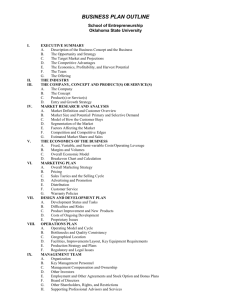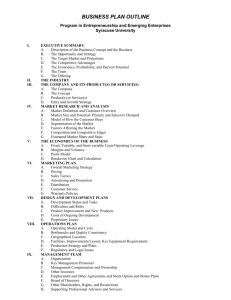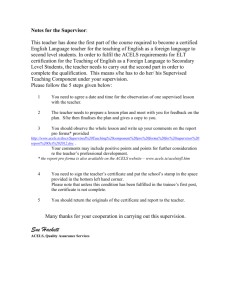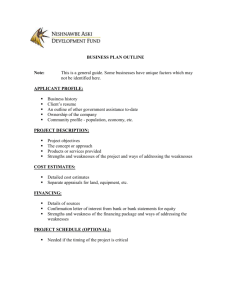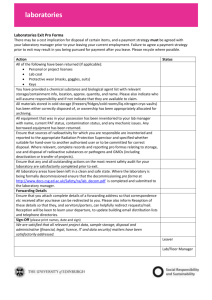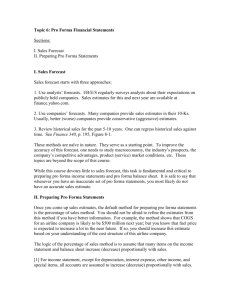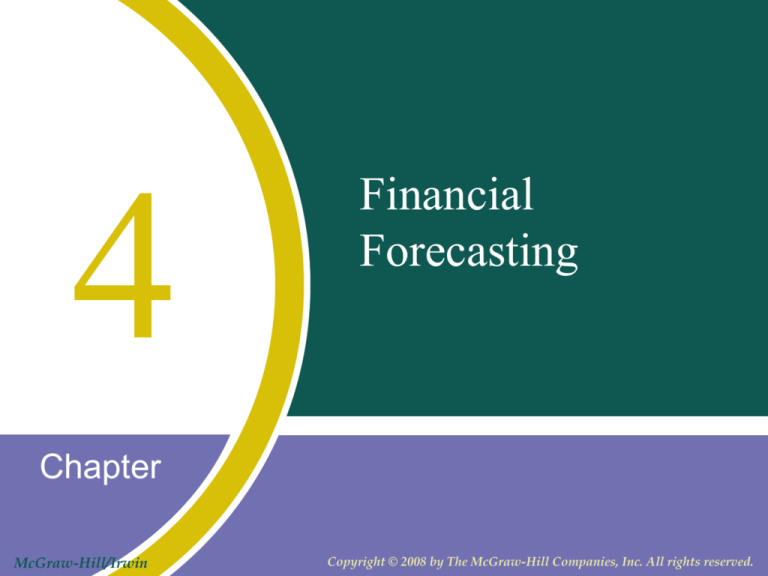
4
Financial
Forecasting
Chapter
McGraw-Hill/Irwin
Copyright © 2008 by The McGraw-Hill Companies, Inc. All rights reserved.
Chapter Outline
• Financial forecasting in a firm’s strategic
growth.
• Three financial statements.
• Percent-of-sales method.
• Various methods to determine the amount of
new funds required in advance.
• Factors that affect cash flow.
4-2
Financial Forecasting
• Ability to plan ahead and make necessary
changes before actual events occur.
• Outcome of a firm through external events
might be a function of both:
– Risk-taking desires.
– Ability to hedge against risk with planning.
• No growth or a decline - not the primary
cause of shortage of funds.
• A comprehensive financing plan must be
developed for a significant growth.
4-3
Constructing Pro Forma Statements
• A systems approach to develop pro forma
statements consists of:
– Constructing it based on:
• Sales projections
• Production plans
– Translating it into a cash budget.
– Assimilating all materials into a pro forma
balance sheet.
4-4
Development of Pro Forma
Statements
4-5
Pro Forma Income Statement
• Provides a projection on the anticipation of
profits over a subsequent period.
– Establish a sales projection.
– Determine a production schedule and the
associated use of new material, direct labor, and
overhead to arrive at a gross profit.
– Compute other expenses.
– Determine profit by completing the actual pro
forma statement.
4-6
Establish a Sales Projection
• Lets assume Goldman Corporation has two
primary products: wheels and casters.
4-7
Stock of Beginning Inventory
• Number of units produced will depend on
beginning inventory.
4-8
Determine a Production Schedule
and the Gross Profit
• To determine the production requirements:
Units
+ Projected sales
+ Desired ending inventory
– Beginning inventory
= Production requirements
4-9
Production Requirements for Six
Months
4-10
Unit Costs
• Cost to produce each unit:
4-11
Total Production Costs
4-12
Cost of Goods Sold
• Costs associated with units sold during the
time period.
– Assumptions for the illustration:
• FIFO accounting is used
• Therefore allocation of cost of current sales to
beginning inventory
• Then to goods manufactured during this period
4-13
Allocation of Manufacturing Costs
and Determination of Gross Profit
4-14
Value of Ending Inventory
4-15
Other Expense Items
• Other expense items must be subtracted
from gross profits to arrive at net profit.
– Earning before taxes
• General and administrative expenses, interest
expenses are subtracted from gross profit.
– Earning after-taxes
• Taxes are deducted from the above sum balance.
– Contribution to retained earnings
• Dividends are deducted from the above sum balance.
4-16
Actual Pro Forma Income Statement
4-17
Cash Budget
• Pro forma income statement must be
translated into cash flows.
– The long-term is divided into short-term pro
forma income statement.
– More precise time frames are set to help in
anticipating the patterns of cash outflows and
inflows.
4-18
Monthly Sales Pattern
4-19
Cash Receipts
• In the case of Goldman Corporation:
– The pro forma income statement is taken for the
first half year:
• Sales are divided into monthly projections.
– A careful analysis of past sales and collection
records shows:
• 20% of sales is collected in the month.
• 80% in the following month.
4-20
Monthly Cash Receipts
4-21
Cash Payments
• Monthly costs associated with:
– Inventory manufactured during the period
(material, labor and overhead).
– Disbursements for general and administrative
expenses.
– Interest payments, taxes and dividends.
– Cash payments for new plant and equipment.
4-22
Component Costs of Manufactured
Goods
4-23
Cash Payments (cont’d)
• Assumptions for the next two tables:
– The costs are incurred on an equal monthly
basis over a six-month period.
– The sales volume however varies each month.
– Employment of level monthly production to
ensure maximum efficiency.
– Payment for material, once a month after
purchases have been made.
4-24
Average Monthly Manufacturing
Costs
4-25
Summary of Monthly Cash
Payments
4-26
Actual Budget
• Difference between monthly receipts and
payments is the net cash flow for the month.
– Allows the firm to anticipate the need for funding
at the end of each month.
4-27
Monthly Cash Budget
4-28
Cash Budget with Borrowing and
Repayment Provisions
4-29
Pro Forma Balance Sheet
• Represents the cumulative changes over
time.
– Important to examine the prior period’s balance
sheet.
– Some accounts will remain unchanged, while
others will take new values.
• Information is derived from the pro forma income
statement and cash budget.
4-30
Development of a Pro Forma
Balance Sheet
4-31
Pro Forma Balance Sheet (cont’d)
4-32
Explanation of Pro Forma Balance
Sheet
4-33
Analysis of Pro Forma Statement
• The growth ($25,640) was financed by
accounts payable, notes payable, and profit.
– As reflected by the increase in retained
earnings.
Total assets (June 30, 2005)……...$76,140
Total assets (Dec 31, 2004)……....$50,500
Increase……………………………..$25,640
4-34
Percent-of-Sales Method
• Based on the assumption that:
– Accounts on the balance sheet will maintain a
given percentage relationship to sales.
– Notes payable, common stock, and retained
earnings do not maintain a direct relationship
with sales volume.
• Therefore percentages are not computed.
4-35
Balance Sheet of Howard
Corporation
4-36
Percent-of-Sales Method (cont’d)
• Funds required is ascertained.
• Financing is planned based on:
– Notes payable.
– Sale of common stock.
– Use of long-term debts.
4-37
Percent-of-Sales Method (cont’d)
• Company operating at full capacity – needs to buy new
plant and equipment to produce more goods to sell:
– Required new funds:
(RNF) = A (ΔS) – L (ΔS) – P (1 – D)
S
S
• Where: A/S = Percentage relationship of variable assets to sales; ΔS
= Change in sales; L/S = Percentage relationship of variable
liabilities to sales; P = Profit margin; = New sales level; D =
Dividend payout ratio.
RNF = 60% ($100,000) – 25% ($100,000) – 6% ($300,000) (1 – .50)
= $60,000 - $25000 - $18,000 (.50)
= $35,000 - $9000
= $26,000 required source of new funds.
4-38
Percent-of-Sales Method (cont’d)
• Company not operating at full capacity - needs to add more
current assets to increase sales :
RNF = 35% ($100,000) – 25% ($100,000) – 6% ($300,000) (1 – .50)
= $35,000 - $25,000 - $18,000 (.50)
= $35,000 - $25,000 - $9,000
= $1,000 required source of new funds.
4-39


